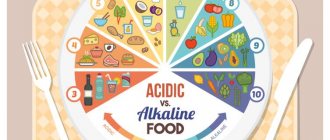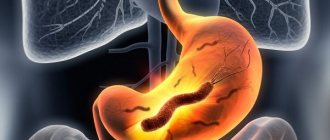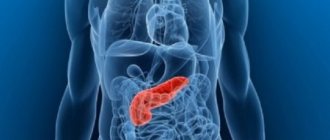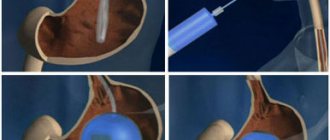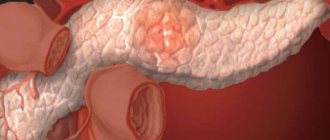27.02.2017
Almost every third woman during pregnancy has problems with bowel movements. Constipation can continue from the first trimester of pregnancy, not only until childbirth, but also up to several weeks after the birth of the child. You should not take this problem lightly, as it negatively affects a woman’s health. As a result, prolonged presence of decay products in the intestines can provoke the formation of toxic substances that negatively affect not only the health of the pregnant woman, but also the fetus. Also, a constant desire to empty the intestines, as a result of which a woman has to constantly push, can lead to the threat of miscarriage, as the tone of the uterus is activated.
Toxic waste that accumulates in the intestines can lead to infection of the fetus due to the fact that the microflora of the cervical canal of the vagina is disrupted. Therefore, if you have constipation during pregnancy, you should consult a gynecologist and nutritionist to eliminate the cause.
Causes
- Z
and due to the increase in progesterone in the pregnant woman’s body, the muscles of the uterus and the smooth muscles of the intestine relax. Due to the reduced activity of the intestinal walls, constipation occurs. - Due to the growth of the uterus during pregnancy, the intestines are displaced and compressed, resulting in poor bowel movements.
- Gastrointestinal problems that the woman previously suffered from begin to manifest themselves more actively, causing constipation.
- Constipation may occur when taking certain medications. For example, iron-containing medications, regulators that normalize the tone of the uterus. The problem may arise when taking complexes that contain calcium.
- During pregnancy, the physical activity of the expectant mother is significantly reduced, which also provokes constipation.
Evaluation of results
The result of treatment is considered satisfactory if the consistency and frequency of stools are normalized. Moderately soft, brown-colored stools are considered normal. The frequency of defecation is 1 time per day. In some cases, it is allowed to pass stool once every 2 days. The patient should have no signs of intestinal hypotonicity - bloating, pain and cramping, false urge to defecate.
Constipation is a serious problem for pregnant women, in the worst case scenario leading to miscarriage or purulent-septic complications. The disease cannot be ignored. If difficulties with bowel movements occur regularly, you should notify the doctor managing your pregnancy. Only a specialist will be able to reliably determine the causes of the pathology and prescribe the necessary treatment. Trying to cope with constipation on your own can lead to serious problems.
Types of constipation
According to the mechanism of action and characteristics of manifestation, constipation is divided into 2 types: spastic and atonic. Each of them requires specially selected products for constipation during pregnancy.
Spastic
Its appearance is associated with an increase in intestinal tone, as a result of which the passage of feces, food and liquid through it is blocked. The reason for the appearance of this type is the mental component, which is associated with increased irritation and emotionality, decreased appetite, lethargy and reluctance to lead an active lifestyle. As a result, many women suffer from frequent flatulence and abdominal pain. Spasms appear in the stomach, and incomplete bowel movements are felt. Very often, a pregnant woman experiences pain in the left side of the abdomen and a regular urge to defecate. In this case, the stool is so dense that it causes pain when emptying. Feces are round fragments that are excreted with difficulty and in small quantities.
Atonic
This type is characterized by a decrease in intestinal tone. This phenomenon is associated with taking certain medications and eating disorders. A pregnant woman feels a feeling of fullness in her intestines, bloating and flatulence. Pain is felt during defecation. The stool is quite abundant, but the movement of feces is difficult. The woman loses her appetite, nausea appears, she feels lethargy, apathy and low mood. A diet for atonic constipation is aimed at improving intestinal microflora and relieving spasms.
Constipation during pregnancy
What is constipation?
Medicine defines constipation as difficult or systematically incomplete bowel movements or as the absence of bowel movements for a day and a half or more.
Constipation often occurs already in the early stages of pregnancy, when the intestines are not yet under pressure from the enlarged uterus, and subsequently haunt the woman throughout the 40 weeks of pregnancy allotted by nature. Moreover, the birth of a child does not always mean normalization of intestinal function. The causes of constipation in different women at different stages of pregnancy and in the postpartum period are different, but all of them are, to one degree or another, associated with disruption of the processes of formation and movement of feces through the intestines, caused by disorders of motor activity (motility) of the intestinal muscles, weakening of the urge to defecate. In turn, these disorders are provoked by a number of changes in the female body. Among them, the most significant are the following:
- A change in hormonal levels that reduces the tone of the muscles of the uterus, and at the same time all other muscle cells similar to them (in the walls of the intestines and in the walls of large vessels).
- Irrational diet of a pregnant woman.
- Changes in the position of the intestines in the abdominal cavity, its gradual displacement by the enlarging uterus at a later date.
- Fear of straining in late pregnancy (rather a psychological problem). More often it occurs in women with increased uterine tone and the threat of miscarriage.
- A sedentary lifestyle, especially with increased uterine tone.
- Psychological stress.
- Congenital features of the intestine, for example, elongated sections.
Types of constipation
There are spastic and atonic constipation, which differ in the mechanism of their occurrence and in the characteristics of their manifestation. Naturally, the diets recommended for different forms of constipation are also different.
The atonic variant is associated with a decrease in the tone of the muscular wall of the intestine; peristalsis (intestinal movements that ensure the movement of food) becomes slow, sluggish and unproductive. This muscle weakness, in turn, can occur due to errors in diet, hormonal changes, and also after operations. Such constipation is accompanied by a feeling of intestinal fullness, aching and nagging pain in the abdomen, flatulence and bloating, lack of appetite, nausea, lethargy , apathy, depressed mood, When defecating there is a lot of feces; their initial portion is shaped, dense, its diameter is larger than usual, the final portion is liquid and mushy. Defecation is painful, even tears in the mucous membrane of the rectum and anus may occur, and then streaks of blood remain on the surface of the stool.
Another form of constipation - spastic - on the contrary, is associated with increased intestinal tone, peristalsis also slows down, but due to the “tight” state of the intestine. Psychological causes are more typical for this type of constipation. In the spastic form, the pain is paroxysmal, even sometimes cramping. They occur more often in the left side of the abdomen along the colon and extend to the left groin area. A woman may be plagued by flatulence (bloating), lack of appetite, inadequate and unexplained fatigue, nervousness, irritability, and nausea. The urge to defecate may occur several times a day, but bowel movements are incomplete, difficult, and in small portions. The feces are very dense and are excreted in separate small rounded fragments, in the form of so-called “sheep feces.”
Constipation associated with lengthening of the large intestine should be especially highlighted. Firstly, their occurrence is not associated with pregnancy, although it can intensify them. Secondly, although outwardly such constipation appears in the same way as spastic ones, they are not associated with increased intestinal tone, but with a longer passage of feces along a longer path. At the same time, more water is absorbed back into the body from the intestinal contents, and the stool becomes hard. Such constipation should be treated not as spastic, but rather as atonic.
Principles of nutrition
To solve the problem of regular bowel movements, it is first necessary to properly organize the nutrition of a pregnant woman.
- You should eat in small portions, but 5 times a day. Long (more than 4 hours) breaks between meals are also unacceptable.
- It is recommended to steam, boil or bake dishes. It is better not to chop food.
- Fresh fruits and vegetables must be included in the diet.
- Kissels, jelly, aspic and jellied meat, as well as fried foods, slow down intestinal motility - these dishes should be avoided.
- It is extremely important to choose a diet taking into account the type of intestinal motility disorder and possible allergic reactions, which are different for each person.
- It is necessary to receive at least 1.5-2 liters per day. liquids, otherwise food cellulose (pectin, etc.) will cease to perform its adsorbing function, which is to “capture” toxic substances. This does not contribute to the normalization of intestinal function, but only increases gas formation and can even provoke colicky pain in the intestines in people prone to spastic reactions. Mineral waters of high and medium mineralization, as well as waters containing magnesium ions and sulfates (for example, Essentuki No. 4 and 17) have a laxative effect. Mineral waters should be at room temperature. They drink them 2-3 times a day, half a glass.
For atonic constipation, the diet is based on the “slag load” type with an increased amount of dietary fiber (in the literature they are also called ballast substances, fiber, cellulose). Dietary fiber is not digested in the digestive tract, some of it is utilized by the intestinal microflora, and some passes through “transit”. The main function of fiber is the adsorption of water, which increases the volume of feces and normalizes peristalsis. In terms of the content of ballast substances in products, food bran (53-55% fiber) is in first place, followed by vegetables (20-24%) and rye bread (5-10%). Refined products: premium white flour, sugar, etc. - do not contain fiber. Ballast substances taken with food have a laxative effect of varying severity on the quality of stool, depending on the ability to bind and adsorb water (the less water is bound, the denser the stool).
It is advisable to eat up to 20-30 g of wheat bran per day, which is doused with boiling water and consumed in pure form or added to liquid dishes. You can also take bran mixed with kefir or yogurt according to the following scheme: starting with 4 teaspoons per day and increasing the dosage by 1 teaspoon per day until regular, gentle bowel movements are restored. After achieving the effect within 2 weeks, the dosage of bran is gradually reduced to the minimum required maintenance dose, this dose is individual for everyone. You should take bran for at least 6 weeks, and you must drink a sufficient amount of liquid - as already mentioned, at least 1.5-2 liters. Daily intake of 30 g of bran shortens the passage time of feces-forming masses by 2-3 times.
Vegetables, fruits and berries, mostly raw, contribute to the activation of the intestines, at least 200 g per day; prunes or dried apricots (8-12 pieces); honey (1 tablespoon 3 times a day - with tea or as an addition to dishes); buckwheat, barley, pearl barley porridge, in particular crumbly ones. Special varieties of bread are useful: grain bread, etc., made with the addition of crushed grain or bran. Drinking cold drinks in the morning on an empty stomach - carbonated or plain water, a glass of cold milk or vegetable juice - helps to empty the intestines. This reflexively causes increased peristalsis.
For spastic constipation, especially if it is accompanied by colicky abdominal pain, a diet rich in dietary fiber may cause increased pain. In such cases, at first, a diet with a low content of coarse dietary fiber is used, respectively, without the addition of bran. Vegetables are allowed mainly in boiled, finely chopped or pureed form. Much attention is paid to vegetable fats: it is recommended to take 1-2 tablespoons of vegetable oil per day on an empty stomach or added to a glass of kefir (drink at night). Meat and fish dishes are also chopped, boiled or steamed. To reduce and subsequently eliminate intestinal spasms, foods containing delicate fiber (for example, dried fruits) are gradually added to food. Since plums contain organic acids that promote bowel movement, despite their relatively low fiber content (only 0.5 g per 100 g of fruit), prunes in any form are recommended for patients with constipation, including infusion, dried fruit puree .
A sample menu can be presented as follows:
- First breakfast: vegetable salad with vegetable oil, steam omelette, tea. Or cottage cheese with sugar and sour cream, oatmeal porridge, tea.
- Second breakfast: fresh apple.
- Lunch: vegetarian cabbage soup with sour cream or beetroot soup. Boiled meat with stewed beets or boiled chicken in milk sauce with cauliflower. Dried fruits compote.
- Afternoon snack: rose hip decoction, cookies.
- Dinner: boiled fish with white sauce and vegetable broth, mashed potatoes, cheesecake with cottage cheese, tea.
- At night: kefir or other fermented milk drinks.
In conclusion, let us remind you that resorting to laxatives and cleansing enemas for constipation is allowed only on the recommendation of the attending physician.
Recommended products and dishes
Bread and flour products. We recommend wheat bread made from second grade flour, or rye if tolerated. All bakery products are only dried, yesterday's baked goods. Unsweetened cookies, dry biscuits, unsweetened baked goods with fruits and berries.
- Soups. They are prepared mainly from vegetables in meat broth; borscht, beetroot soup, cabbage soup made from fresh cabbage, and cold fruit and vegetable soups are recommended. Meat and poultry. You can eat lean varieties of various types of meat, chicken, turkey (boiled or baked, in pieces or chopped), and milk sausages. Fish. Low-fat and moderately fatty types of fish (cod, hake, ice fish, pike perch, navaga, etc.) are allowed - boiled and baked.
- Dairy products. Whole milk is acceptable - if tolerated well or as an addition to various dishes. Various fermented milk drinks are recommended: kefir, yogurt, acidophilus (good for the night!), fresh cottage cheese and dishes made from it: puddings, lazy dumplings and cheesecakes. Cream and sour cream are allowed as additions to dishes.
- Eggs. No more than 1 egg per day is allowed. Eggs can be soft-boiled or hard-boiled (if tolerated), added to dishes; You can eat steamed omelettes.
- Cereals. Recommended are crumbly porridges, casseroles and krupenniki (porridges baked with cottage cheese) made from buckwheat, millet, wheat and barley groats, cooked in water with the addition of milk, and muesli. Rolled oats porridge in water with vegetable oil is useful.
- Vegetables. Healthy foods include beets, carrots, tomatoes, lettuce, cucumbers, zucchini, pumpkin, cauliflower, and broccoli—raw and boiled for side dishes and casseroles. White cabbage and green peas are consumed boiled if tolerated well. Potatoes are allowed, but in limited quantities. Squash caviar is useful as a snack.
- Snacks. Salads from raw vegetables and vinaigrettes with vegetable oil, fruit salads are recommended; mild cheese, low-fat ham, boiled tongue, soaked herring once a week.
- Fruits. You can eat non-sour, ripe, sweet fruits and berries - raw and baked. Natural juices are beneficial - better with pulp. Dried fruits (prunes, dried apricots, apricots, figs) are consumed soaked and in various dishes, in compote.
- Sweets. Honey, jam in small quantities, marmalade, marshmallows, and milk caramel are allowed.
- Sauces and spices. Sauces are prepared with weak meat and fish broth; bechamel milk sauce is used, less often sour cream and fruit sauce. Dill, parsley, celery are added to dishes.
- Beverages. Weak tea, substitute coffee and weak natural coffee are acceptable; decoction of rose hips and wheat bran, fruit and vegetable juices (from plums, apricots, carrots, etc.).
- Fats. You can use butter, soft (bulk) margarine; vegetable oils - in dishes (including olive oil).
The following have slight independent laxative properties: olives, dried fruit compotes, raw, boiled or soaked prunes, honey, watermelon, melon, apples, apricots, grapes, red currants or their juice, cherries.
Foods to Avoid or Limit
Patients with constipation and complaints of bloating should limit or even exclude from the diet foods that are rich in dietary fiber and cause increased gas formation, namely: legumes, cabbage, sorrel, spinach, apple and grape juices. Vegetables rich in essential oils are limited or even prohibited: onions, garlic, radishes, radishes, turnips. Foods containing tannin delay bowel emptying: blueberries, quince, dogwood, pears, pomegranate, hawthorn, bananas, black currants, strong black tea, cocoa, chocolate. Intestinal motility is inhibited by pureed food, substances with a viscous consistency (mucous soups, porridges, especially semolina, rice and potato dishes), as well as refractory fats (pork, lamb, beef, shortening).
Not recommended: bread made from premium flour, butter dough, pasta, noodles, strong broths, fatty meats and fish, mushrooms, spicy dishes and seasonings (horseradish, mustard, pepper), smoked and canned foods, walnuts, hard cheeses, milk with poor tolerance.
Principles of nutrition
To avoid constipation and solve problems with regular bowel movements, you must first follow a diet. You need to eat foods that are rich in fiber. These include vegetables and fruits. They should not be subjected to heat treatment. To avoid constipation, you should resort to fractional meals. You need to eat food in small portions up to 5-6 times a day. There should be at least 4 hours between each meal. Preference should be given to boiled food and fermented milk products. Porridges are combined with vegetables and meat, and fermented milk products with fruits and grains. Yogurts with grains or prunes are especially healthy. Daily consumption of olive oil will ease the condition. It must be taken one tablespoon every morning. This is an excellent preventative for pregnant women who do not suffer from constipation.
The diet for constipation in pregnant women differs in the consumption of foods, depending on whether the woman has atonic or spastic constipation. When creating a menu, it is necessary to take into account all the nuances in order to prevent constipation in a pregnant woman.
Treatment
Most laxatives used to treat patients of other categories are contraindicated for pregnant women. The fight against constipation is carried out using non-drug methods. The patient is recommended to change her lifestyle, increase physical activity, daily walking, and swimming. A prerequisite is the correction of water balance. A woman should drink at least 1.5 liters of clean drinking water per day. The liquid entering the body as part of other dishes is taken into account.
There are no significant dietary restrictions. You should use foods rich in fiber: prunes, fresh vegetables and fruits. In the intestines, cellulose swells, increasing the size of the food bolus and increasing mechanical stimulation of receptor zones. This helps to activate peristalsis. You should avoid using:
- coffee;
- strong tea;
- white bread;
- semolina porridge;
- lingonberries;
- blueberries
If constipation is a consequence of other diseases, their correction is required. Medicines that reduce peristalsis are discontinued or replaced with analogues. Laxatives are prescribed only if these treatment methods are ineffective.
Drug therapy
Lactulose is used as the main therapy. It is not absorbed or broken down in the intestines and does not have a systemic effect. In the colon, the drug is oxidized by microflora to fatty acids, which increase osmotic pressure. Prevents the reabsorption of water, makes stool softer and facilitates their elimination. Prescribed 30 ml, 1 time per day, before meals. If necessary, the number of doses can be increased to 2 times a day.
Another drug that is safe for pregnant women is Macrogol. The drug is not absorbed or metabolized and does not have a systemic effect. Retains water in the intestinal lumen, which helps soften the consistency of the stool. You should take the medicine 1-2 sachets per day, preferably in the morning. Before use, dissolve the powder in a glass of warm water.
Hypomotor dyskinesias in the 2nd and 3rd trimester can be relieved using the prokinetic agent metoclopramide. The drug is prescribed according to the doctor’s decision when the benefit to the mother outweighs the possible risk to the fetus. For constipation in the initial stages of pregnancy, Metoclopramide is contraindicated.
Products for spastic constipation
It is necessary to eat foods that will help relax the intestines and reduce muscle tone. It is recommended to exclude from the menu:
- cold food;
- spicy and fatty foods;
- spices;
- products with coarse fiber;
- raw vegetables.
Vegetables can only be consumed steamed. Preference is given to boiled meat and fish dishes. You should definitely include dried fruits, jelly, aspic, and meat broths in your diet. It is advisable to eat chopped food, which is ground in advance in a blender.
Symptoms of constipation
Any deviation from normal bowel movements is abnormal and does not occur without reason. Pregnancy is a common cause of such abnormalities in women.
It is normal for a pregnant woman to empty her bowels from once every three days to twice a day, unless side symptoms are observed.
Why is that? Yes, because each person’s physiology is individual, and everyone knows what’s best for him. If a person is comfortable going to the toilet once every three days, then why not, but if at this rate he begins to notice the presence of side symptoms, then constipation may begin.
In another case, someone needs to have a bowel movement once a day, but once every three days, for such a person there is already a state of constipation.
What are these side symptoms? These are the symptoms that appear with the usual frequency of bowel movements for each person, but indicate a malfunction in the body and possible constipation.
These signs of constipation include:
- feces become very hard and dry, and therefore difficult to come out of the anus;
- during defecation there is pain in the anus;
- after the emptying process, a feeling of incompleteness remains;
- feces become less and less, it can change its shape and become like goat poop;
- blood, pus and mucus may be found in the stool;
- weakness and malaise are noted;
- rashes appear on the face and even on the body;
- headache occasionally makes itself felt, the longer there is no stool, the more often it manifests itself.
If constipation is not treated, these symptoms quickly begin to progress, leading to very poor health of the woman, as well as abnormal functioning of her body. Therefore, it is important not to delay treatment to avoid complications.
Products for atonic constipation
In this case, food should be enriched with plant fiber, which can be used to normalize intestinal motility. Bread products must be made from whole grain flour. It is recommended to use more fruits, vegetables and berries. They are recommended to be eaten fresh. Dried apricots and prunes cope well with this type of constipation. You can drink vegetable fruit juices, milk and mineral water. Porridge, fermented milk products, and soups normalize intestinal function.
It is prohibited to use:
- spicy foods and seasonings;
- smoked and fatty foods;
- marinades and pickles;
- baked goods and confectionery;
- concentrated juices and strong tea;
- legumes;
- nuts;
- hard cheeses;
- carbonated drinks;
- canned food
Folk remedies for constipation during pregnancy
In the old days, pharmacology was not so developed and to combat constipation, women used proven remedies from traditional medicine. They can still be used today. Thus, a decoction based on prunes can play a good role in the process of normalizing digestion.
It is prepared as follows - equal proportions of prunes, oatmeal and beets are taken. Next, the components are mixed, filled with water and placed on the stove. After boiling, the broth should be brought to readiness over low heat for an hour. You need to consume the prepared dish one glass at night.
A mixture of honey and dried fruits also has a beneficial effect on the digestion process. To prepare it you need raisins, dried apricots and prunes. They are crushed and mixed with honey. For 300 grams of dried fruit you need to use about two tablespoons of honey. The mixture should be consumed before bedtime with water.
These methods have a mild effect, unlike other folk remedies against constipation, such as an infusion of senna leaves, buckthorn bark or rhubarb stems. Therefore, doctors recommend strictly avoiding the use of the latter methods during pregnancy.
General recommendations
Regardless of the type of constipation, pregnant women should eat in such a way as to prevent flatulence and bloating. It is recommended to avoid the consumption of onions, garlic and all products that contain essential oils. These also include radishes, turnips and radishes.
Blueberries, pears, hawthorns, bananas and pomegranates delay bowel movements. These products should not be consumed if you are constipated. It is also worth limiting the consumption of dishes that include legumes, cabbage, spinach, and sorrel. You cannot drink apple and grape juice, cocoa and strong tea.
All these products can not only harm the stomach during pregnancy, but also cause constipation. Do not forget that constipation not only causes discomfort to a woman, but can also cause hemorrhoids or various gastrointestinal diseases.
What are the dangers of constipation in early pregnancy?
Disruption of the gastrointestinal tract in patients expecting a child is most often expressed in stool retention for several days. If this condition lasts more than 3 days, it is necessary to take appropriate measures, since constipation can cause various problems for the expectant mother:
- A woman will most often be bothered by heaviness and bloating in the abdomen, and severe abdominal pain is possible. Since patients are not recommended to take many of the usual medications during the first 2 to 3 months of fetal development, it will not be easy to cope with such symptoms.
- Constant constipation can increase pressure in the abdominal cavity, which can provoke an increase in the tone of the uterus. This is already a direct threat of possible spontaneous abortion.
- In the first trimester, the formation of all the main organs of the unborn child occurs, and disturbances in the gastrointestinal tract contribute to stagnation in the intestines. This situation often leads to the fact that food breakdown products enter the patient’s blood. This is already an immediate threat to the fetus.
- It is best to solve the problem of constipation in the early stages of pregnancy and not postpone it until after childbirth. Pathological microflora of the colon can provoke various inflammatory diseases of the birth canal, which can negatively affect childbirth.
- Violation of the normal functioning of the intestines often causes the development of hemorrhoids in the expectant mother. A pregnant woman already has a high probability of problems with hemorrhoids, since the process of bearing a fetus is accompanied by stagnation in the veins of the pelvis, and constipation only aggravates this problem.
There are quite a few reasons why constipation occurs during early pregnancy. Even psychological problems can become an impetus for irregular bowel movements. Doctors at the antenatal clinic can recommend a pregnant woman a whole range of measures to combat this disease. The basis of all these measures is the prevention of stagnation in the intestines and stabilization of the gastrointestinal tract.
Watch the video about the causes of constipation:



